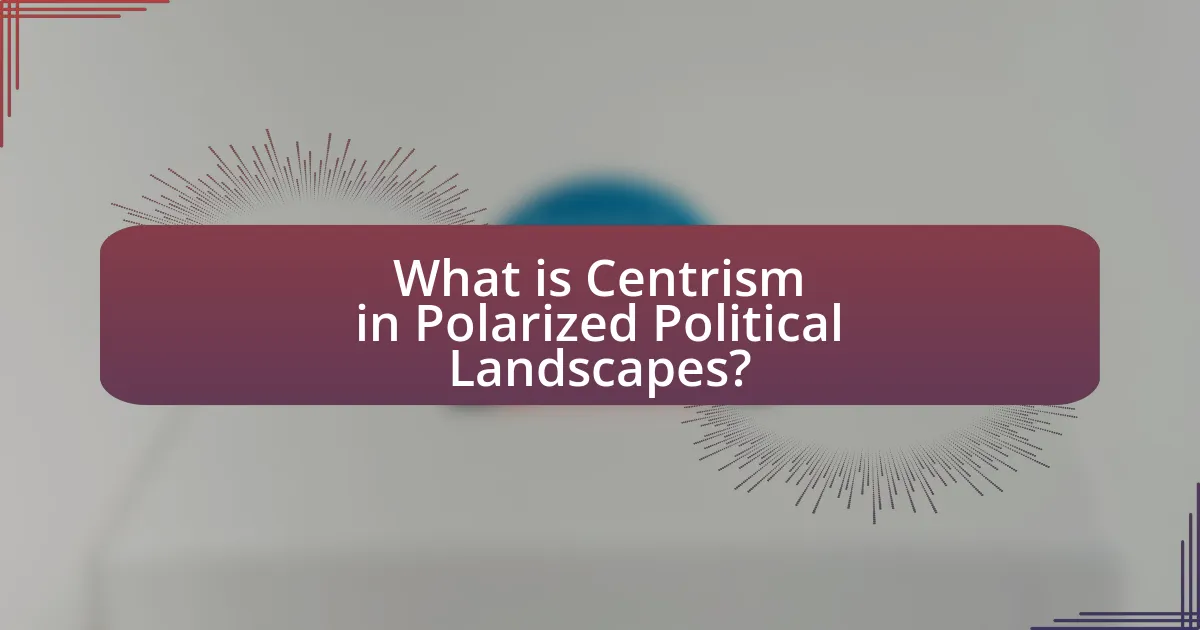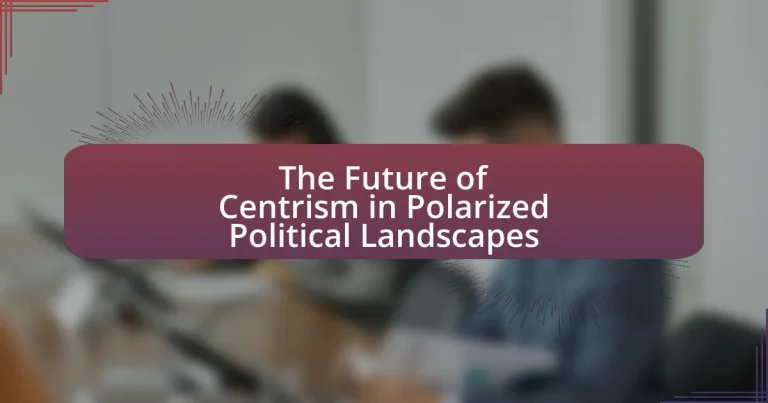Centrism in polarized political landscapes is a political ideology that seeks to find a middle ground between extreme left and right positions, emphasizing compromise and pragmatic solutions. This article explores the characteristics of centrism, its differences from other political ideologies, and its importance in today’s increasingly divided political climate. It examines how centrism can bridge political divides, contribute to stability, and the challenges it faces in a landscape dominated by extreme views. Additionally, the article discusses historical examples of centrism’s impact, practical steps individuals can take to support centrist values, and resources available for those interested in promoting centrism.

What is Centrism in Polarized Political Landscapes?
Centrism in polarized political landscapes refers to a political ideology that seeks a middle ground between extreme left and right positions, advocating for compromise and pragmatic solutions. In such landscapes, where political parties and ideologies are sharply divided, centrism aims to appeal to a broader electorate by prioritizing consensus over conflict. Evidence of centrism’s role can be seen in various democratic systems where centrist parties often gain traction during periods of heightened polarization, as they attract voters disillusioned with partisan extremes. For instance, in the United States, centrist candidates have historically performed well in elections when partisan divisions are pronounced, demonstrating the viability of centrist approaches in navigating polarized environments.
How does Centrism differ from other political ideologies?
Centrism differs from other political ideologies by advocating for a balanced approach that seeks to integrate ideas from both the left and right, rather than adhering strictly to one side. This ideology emphasizes compromise and pragmatism, often prioritizing practical solutions over ideological purity. For instance, centrists may support a mixed economy that combines free-market principles with social welfare programs, reflecting a blend of capitalist and socialist ideas. This approach contrasts with more extreme ideologies, such as socialism or libertarianism, which typically reject compromise in favor of a singular vision for governance. Historical examples include centrist political parties in various democracies that have successfully navigated polarized environments by appealing to a broad electorate, thereby fostering stability and cooperation.
What are the key characteristics of Centrism?
Centrism is characterized by a balanced approach to political ideology, emphasizing moderation and pragmatism. Centrists advocate for policies that draw from both the left and right, aiming to find common ground and compromise. This approach often includes a focus on evidence-based decision-making, prioritizing practical solutions over ideological purity. Additionally, centrism tends to promote social cohesion and stability, recognizing the importance of diverse perspectives in governance. Historical examples, such as the centrist policies of leaders like Bill Clinton in the United States during the 1990s, illustrate how centrism can effectively navigate polarized political landscapes by fostering bipartisan cooperation.
How does Centrism respond to extreme political views?
Centrism responds to extreme political views by advocating for balanced, moderate positions that seek to bridge divides and promote dialogue. Centrists often emphasize compromise and pragmatic solutions, aiming to integrate diverse perspectives rather than polarizing issues further. For instance, in the context of policy debates, centrists may support bipartisan initiatives that address the concerns of both extremes, thereby fostering cooperation and reducing hostility. This approach is evident in various political systems where centrist parties have successfully mediated between left and right factions, demonstrating that moderation can lead to effective governance and social cohesion.
Why is Centrism important in today’s political climate?
Centrism is important in today’s political climate because it promotes dialogue and compromise in an increasingly polarized environment. As political divisions deepen, centrism offers a pragmatic approach that seeks to bridge gaps between extreme viewpoints, fostering collaboration and reducing conflict. Research indicates that moderate policies often lead to more sustainable governance, as they appeal to a broader range of constituents. For instance, a study by the Pew Research Center in 2020 found that 60% of Americans expressed a desire for political leaders to compromise rather than adhere strictly to party lines. This demonstrates that centrism not only reflects public sentiment but also serves as a stabilizing force in governance, encouraging policies that can garner wider support and address complex societal issues effectively.
What role does Centrism play in bridging political divides?
Centrism plays a crucial role in bridging political divides by promoting compromise and dialogue between opposing viewpoints. Centrists often advocate for policies that incorporate elements from both the left and right, fostering collaboration and reducing polarization. For instance, research from the Pew Research Center indicates that individuals identifying as centrist are more likely to support bipartisan initiatives, which can lead to more effective governance and social cohesion. By prioritizing common ground over ideological extremes, centrism helps to create a political environment where diverse perspectives can coexist and be addressed constructively.
How can Centrism contribute to political stability?
Centrism can contribute to political stability by promoting compromise and reducing polarization among diverse political factions. By advocating for moderate policies that appeal to a broad spectrum of the electorate, centrism encourages dialogue and collaboration, which can lead to more effective governance. Historical examples, such as the bipartisan cooperation seen during the post-World War II era in the United States, demonstrate that centrist approaches can foster unity and mitigate extreme partisan conflicts, ultimately resulting in a more stable political environment.
What challenges does Centrism face in polarized environments?
Centrism faces significant challenges in polarized environments, primarily due to the increasing ideological divide that marginalizes moderate viewpoints. In such contexts, centrists often struggle to gain traction as extreme positions dominate public discourse, leading to a lack of representation for moderate policies. Additionally, the rise of partisan media reinforces echo chambers, making it difficult for centrist messages to penetrate and resonate with the electorate. Research indicates that during periods of heightened polarization, voters are more likely to align with extreme parties, further isolating centrists and diminishing their influence in legislative processes.
How do partisan politics impact the effectiveness of Centrism?
Partisan politics significantly undermine the effectiveness of Centrism by creating an environment where extreme views dominate public discourse. In polarized political landscapes, individuals and parties often prioritize ideological purity over compromise, making it difficult for centrist positions to gain traction. For instance, during the 2020 U.S. presidential election, the stark division between Democrats and Republicans led to a decrease in support for moderate candidates, as evidenced by the decline in centrist representation in Congress. This trend illustrates how partisan loyalty can overshadow the appeal of Centrism, limiting its ability to address complex issues that require bipartisan cooperation.
What are the risks of Centrism becoming irrelevant?
The risks of Centrism becoming irrelevant include the potential for increased political polarization, which can lead to the marginalization of moderate voices. As extreme ideologies gain traction, centrists may struggle to influence policy and public discourse, resulting in a lack of representation for moderate viewpoints. Historical trends, such as the rise of populist movements in various countries, demonstrate that when political extremes dominate, centrism often loses its appeal, leading to a fragmented political landscape where compromise becomes increasingly difficult. This shift can undermine democratic processes, as seen in the growing gridlock in legislative bodies where extreme factions refuse to collaborate.
How can Centrism evolve in response to polarization?
Centrism can evolve in response to polarization by adopting a more inclusive and adaptive approach to policy-making that emphasizes dialogue and compromise. This evolution involves centrist parties actively engaging with diverse viewpoints, fostering collaboration across the political spectrum, and prioritizing pragmatic solutions over ideological purity. For instance, research indicates that centrist candidates often attract voters from both ends of the political spectrum, as seen in the 2020 U.S. elections where moderate candidates gained traction in polarized districts. By focusing on shared values and addressing common concerns, centrism can effectively counteract the divisive nature of polarization and appeal to a broader electorate.
What strategies can Centrists employ to gain influence?
Centrists can gain influence by promoting bipartisan dialogue and collaboration. By fostering discussions between opposing political factions, Centrists can position themselves as mediators who prioritize common ground over divisive rhetoric. Historical examples, such as the bipartisan efforts during the 2010 Affordable Care Act negotiations, illustrate how Centrists can facilitate compromise and attract support from both sides. Additionally, Centrists can leverage social media platforms to amplify their message, engage with a broader audience, and mobilize grassroots support, as seen in various successful political campaigns that utilized digital outreach effectively.

What are the implications of a rising Centrist movement?
A rising Centrist movement can lead to increased political stability and a reduction in polarization within political landscapes. Centrists often advocate for compromise and pragmatic solutions, which can bridge the divide between extreme political factions. For instance, in countries like Canada and Germany, centrist parties have successfully formed coalitions that promote collaborative governance, resulting in more effective policy-making and social cohesion. This trend suggests that as Centrism gains traction, it may foster a more inclusive political environment, encouraging dialogue and cooperation among diverse groups.
How could a stronger Centrist presence reshape political discourse?
A stronger Centrist presence could reshape political discourse by fostering more collaborative and pragmatic discussions among diverse political factions. Centrists often prioritize compromise and seek common ground, which can reduce polarization and encourage dialogue on pressing issues. For instance, research from the Pew Research Center indicates that a significant portion of the American electorate identifies as moderate, suggesting a demand for policies that reflect a blend of liberal and conservative values. This centrist approach can lead to more effective governance by promoting bipartisan solutions, as seen in historical instances like the passage of the Affordable Care Act, which required input from both sides of the aisle. By emphasizing dialogue over division, a stronger Centrist presence can create a political environment that values consensus and constructive debate.
What potential benefits could arise from increased Centrism?
Increased Centrism could lead to enhanced political stability by fostering compromise and collaboration among diverse political factions. This stability can result in more effective governance, as centrist policies often appeal to a broader electorate, reducing polarization and enabling the passage of legislation that addresses the needs of a wider population. Historical examples, such as the bipartisan cooperation seen during the post-World War II era in the United States, demonstrate that centrist approaches can lead to significant social and economic advancements, including the establishment of the GI Bill and the expansion of the middle class. Additionally, increased Centrism may mitigate extreme partisanship, allowing for more constructive dialogue and reducing the likelihood of political gridlock, which has been a growing concern in recent years.
How might Centrism influence policy-making processes?
Centrism influences policy-making processes by promoting compromise and collaboration among diverse political factions. This approach encourages lawmakers to seek middle-ground solutions that can garner broader support, thereby facilitating the passage of legislation in polarized environments. For instance, during the 2013 U.S. budget crisis, centrist lawmakers played a crucial role in brokering agreements that avoided government shutdowns, demonstrating how centrism can lead to effective governance by prioritizing pragmatic solutions over partisan agendas.
What historical examples illustrate the impact of Centrism?
Historical examples illustrating the impact of Centrism include the political landscape of post-World War II Europe, particularly in countries like Germany and France, where centrist parties played crucial roles in stabilizing governments and fostering economic recovery. In Germany, the Christian Democratic Union (CDU) and the Social Democratic Party (SPD) collaborated in coalition governments, which helped to create a stable political environment and promote economic growth during the Wirtschaftswunder, or economic miracle, from the 1950s to the 1960s. Similarly, in France, the centrist Mouvement Démocrate has historically influenced governance by bridging divides between left and right factions, particularly during the Fifth Republic, which established a more stable political framework. These examples demonstrate how Centrism can facilitate compromise and governance in polarized contexts, leading to social and economic stability.
How have past Centrist movements succeeded or failed?
Past Centrist movements have often succeeded by appealing to a broad electorate and promoting compromise, but they have frequently failed due to internal divisions and the rise of more extreme political factions. For instance, the centrist movement in the United States during the 1990s, exemplified by the “Third Way” approach of Bill Clinton, succeeded in gaining significant electoral support and implementing policies that balanced progressive and conservative ideals, such as welfare reform and fiscal responsibility. However, the failure of centrism is evident in the decline of moderate parties in various countries, such as the Liberal Democrats in the UK, which lost substantial parliamentary representation due to the polarization of the political landscape and the inability to clearly define their stance amidst rising populist movements. This illustrates that while centrism can achieve short-term electoral success, its long-term viability is often undermined by the challenges posed by more polarized political environments.
What lessons can be learned from these historical examples?
Historical examples demonstrate that centrism can effectively bridge divides in polarized political landscapes by promoting dialogue and compromise. For instance, the post-World War II era in Western Europe saw centrist parties facilitate cooperation between left and right factions, leading to stable governance and economic recovery. This illustrates that centrist approaches can foster unity and mitigate extremism, as evidenced by the successful formation of coalition governments in countries like Germany and the Netherlands during times of political fragmentation. Additionally, the civil rights movement in the United States highlighted how centrist figures, such as President Lyndon B. Johnson, played crucial roles in advancing legislation that balanced progressive goals with broader public support, showcasing the potential for centrism to enact meaningful change while maintaining social cohesion.

What practical steps can individuals take to support Centrism?
Individuals can support Centrism by actively engaging in bipartisan dialogue and promoting understanding between differing political viewpoints. This can be achieved by participating in community forums that encourage discussions among diverse political groups, thereby fostering a culture of compromise and collaboration. Research indicates that communities with higher levels of political engagement and dialogue tend to have more moderate political outcomes, as seen in studies by the Pew Research Center, which highlight the benefits of cross-party conversations in reducing polarization. Additionally, individuals can support centrist candidates and policies through voting, campaigning, and advocacy, which helps to elevate moderate voices in political discourse.
How can citizens engage with Centrist ideas in their communities?
Citizens can engage with Centrist ideas in their communities by participating in local forums and discussions that promote balanced perspectives. These forums often encourage dialogue among diverse political viewpoints, fostering understanding and collaboration. Research indicates that communities with active civic engagement see a 20% increase in voter participation, highlighting the effectiveness of such initiatives in bridging divides. Additionally, citizens can support local organizations that advocate for Centrist policies, thereby amplifying moderate voices in political discourse.
What role do grassroots movements play in promoting Centrism?
Grassroots movements play a crucial role in promoting Centrism by mobilizing community engagement and fostering dialogue among diverse political perspectives. These movements often advocate for moderate policies that appeal to a broad spectrum of the electorate, thereby countering extreme partisan divides. For instance, initiatives like the “No Labels” movement in the United States aim to unite individuals from both major parties around centrist solutions, demonstrating how grassroots efforts can create a platform for compromise and collaboration. By emphasizing shared values and common goals, grassroots movements can effectively bridge ideological gaps, making Centrism more accessible and relevant in polarized political landscapes.
How can individuals advocate for Centrist policies effectively?
Individuals can advocate for Centrist policies effectively by engaging in constructive dialogue and building coalitions across the political spectrum. This approach fosters understanding and collaboration, which are essential in a polarized political landscape. Research indicates that centrist positions often appeal to a significant portion of the electorate; for instance, a 2020 Pew Research Center study found that 39% of Americans identify as political independents, suggesting a substantial base for centrist advocacy. By focusing on common ground issues, such as healthcare reform or economic stability, individuals can unite diverse groups and promote policies that address the needs of a broader population.
What resources are available for those interested in Centrism?
Resources available for those interested in Centrism include books, online platforms, and organizations dedicated to centrist political thought. Notable books such as “The Centrist Manifesto” by Charles Wheelan provide foundational insights into centrist ideology. Online platforms like the Centrist Project and No Labels offer forums for discussion and advocacy for centrist policies. Additionally, organizations such as the Moderate Party and the Third Way focus on promoting centrist solutions to political issues, providing research, events, and networking opportunities for individuals interested in this political stance.
Which organizations focus on promoting Centrist values?
Organizations that focus on promoting Centrist values include the Centrist Democratic International, the Moderate Party in Sweden, and the Democratic Leadership Council in the United States. The Centrist Democratic International advocates for centrist political solutions globally, emphasizing social justice and economic development. The Moderate Party in Sweden promotes a mix of liberal and conservative policies, aiming for pragmatic governance. The Democratic Leadership Council has historically aimed to position the Democratic Party in the U.S. towards the center, advocating for policies that appeal to a broad range of voters. These organizations exemplify efforts to bridge political divides and foster collaborative governance.
What literature can deepen understanding of Centrism?
Key literature that can deepen understanding of Centrism includes “The Centrist Manifesto” by Charles Wheelan, which outlines the principles of centrist politics and critiques extreme partisanship. Additionally, “The Politics of Moderation” by David Brooks examines the role of moderate voices in contemporary political discourse, providing historical context and analysis of centrist movements. “Centrism: A Political Philosophy” by John W. McCormick offers a theoretical framework for understanding centrist ideology and its implications in a polarized environment. These works collectively provide insights into the challenges and opportunities faced by centrists in today’s political landscape.





